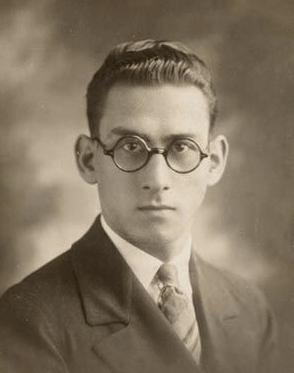One of the issues facing Golden Dawn researchers is that there is a lot of retrospective projection which goes on, and things that you expect to be there turn out to be untrue, or are based on stuff which is assumed.
This week, Facebook has been getting its collective knickers in a twist about Israel Regardie’s Middle Pillar, a staple of the modern Golden Dawn system. Regardie himself considered the middle pillar a vital part of the magical work and insisted his students do it daily. It is not a bad exercise, and in no way I am decrying its usefulness.

Israel Regardie the Harry Potter years
However, many people think it is a Golden Dawn exercise, which it isn’t. Pointing this out on Facebook gets people rather cross.
The issue is that there was an exercise in the Golden Dawn which was similar to Regardie’s Middle Pillar and even a cut-down version it which looks pretty similar. The argument is that Regardie took his Middle Pillar from the Golden Dawn, and therefore, it is a GD exercise. Logic is fueled by the fact that Regardie’s Middle Pillar book was written in 1936 after he left the Bristol Temple of the Stella Matutina.
But Regardie’s Middle Pillar has important differences from the Golden Dawn version.
Firstly the Golden Dawn version has you visualising the spheres on your body. It does not have you vibrating names on those spheres. As we will see later, this difference is important. The spheres are visualised in order and connect to the feet and then stops. There is no circulation of force, no fountain breath. In short, the Golden Dawn ritual is a visualisation of drawing down energy into the sphere of sensation – “literally projecting the Tree of Life onto the Sphere of Sensation.” Regardie’s version is much more ambitious. It is taking those spheres and energising them with chanting divine names. It is then using this force in a similar way to Tantric kundalini. It is not just drawing power down but raising it upwards.
Regardie’s version is more intelligent and practical than the Golden Dawn paper, which was not exactly rocket science.
Another important thing is that while the Golden Dawn papers existed on the subject, they were not universally read or adopted. They were not official and we have no idea how widely they were distributed. We don’t know if Regardie ever saw those papers. He never mentioned it, and at the time of writing I am unsure if he ever called it a Golden Dawn technique (it was not described as such in the Art of True Healing.)
One of the arguments for Regardie stealing the idea is that his mentor Aleister Crowley gave him the material. However, Regardie himself said that Crowley gave him no magical information at all and besides all copies of this paper were issued long after Crowley had left the Golden Dawn.
The point is that when modern Golden Dawn people look at historical documents, they are seeing what they want to see. Because they use the Middle Pillar then expect to see it being used in some form in the GD. To them such a paper provides “proof” when it suggests a parallel development at best.
Another issue was the Lesser Banishing Ritual of the Pentagram, which is a modern Golden Dawn obsession. This concept comes from Regardie and probably emerged in the 1960s. The contemporary idea is you banish before you do any work. It is assumed to be in the original Golden Dawn because the first knowledge paper mentions it.
However, as I discovered when I started doing my research on the Banishing Pentagram, the first knowledge paper mentioned banishing as a footnote. Reading the first knowledge paper without modern blinkers talks about the daily use of the invoking for protection and the banishing on if doing a ritual in unfamiliar space or if threatened. In fact, Tony Fuller has a letter from Annie Horneman warning about demagnetising the sphere of sensation by doing the banishing too often. Whare Ra forbade using the pentagram in its temple space (which had its own protections).
While there is nothing wrong with innovation, there are issues when you project modern material onto older sources.
Another example is Regardie’s watchtower ritual, which was based on the GD vault ceremony with extra Enochian and the supreme ritual added. Many of the problems that many people have with the GD can be sourced to this particular ritual, and it is essential to state that while it uses GD components, it is typically Regardie. It is overblown, dull and relatively redundant.
If you follow Regardie, you must do a lesser banishing pentagram, a lesser banishing hexagram, a version of the supreme programme, a rather clunky purification and consecration, an Enochian Call the keyword before you get to the main bit, which might require additional lesser or greater hexagrams.
It is hard to see how half of that is needed, and there is no indication that the GD thought it was so either. If something like the watchtower needed to be done before every rite, Mathers would have written a paper for it. By supplying one after he left the GD Regardie confined the GD in his own purple image (which has its roots in Crowley and Allan Bennett, his teacher). If we look at other GD rituals, we are often shocked about how basic and concise they are, or just followed rituals like the Key of Solomon just adding in Golden Dawnisms.

Comments are closed